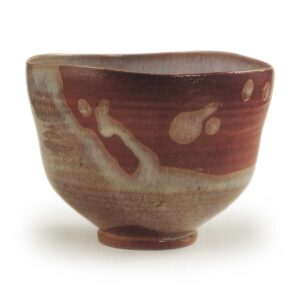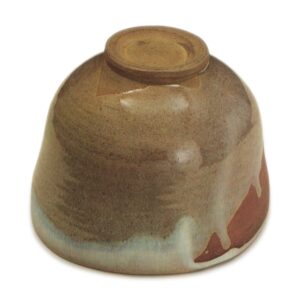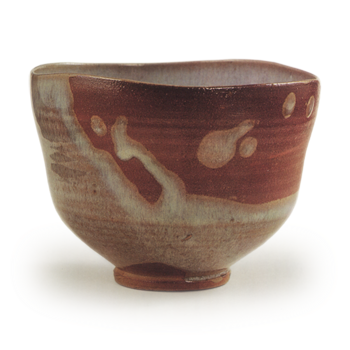

Height: 9.5cm
Diameter: 11.7-12.6cm
Foot diameter: 5.0cm
Height: 0.7cm
From ancient times, the Katamono-nami tea bowl was highly regarded as one of the two best examples of Nonomura Ninsei’s work in Kaga, along with the Nokuji Kin-suji tea bowl. The name of this tea bowl is thought to come from the fact that the glaze on the bowl resembles waves.
In addition to his colorful ceramics, Ninshō also produced works in the Seto and Shigaraki styles, and many of the Shigaraki-style works that show the texture of the clay body, such as this tea bowl, have a cloudy white glaze that is applied in a pouring style.
In the tea bowls, the technique is also used in the “Scale Wave Tea Bowl” shown in this book, and other bowls such as the “Rutsusen Tea Bowl” and the “Shinobigusa Tea Bowl” are also made in a similar way in terms of both glaze technique and shape, and can be said to be tea bowls in a style unique to Nonomura.
However, among the tea bowls of a similar style, Katamono-nami stands out as a particularly unique tea bowl. While the other tea bowls all use overglaze enamels, this tea bowl only uses a glaze, and it still achieves a sufficient design effect. Furthermore, among the tea bowls of the type that I have seen, there is none that gives such a strong sense of technical artifice, and despite its simple coloring, it is truly exquisite.
The foot ring is clearly cut out as if a round seat had been laid down, and the foot ring tatami mat is cut out thinly, as is often seen in Nisei tea bowls, and the mark “Nisei” is stamped on the left side of the foot ring inside.
The entire inside and outside surfaces are covered with a milky white glaze (nangoro-yō), but on one side of the outside, there is a crescent-shaped area of exposed clay from the rim to the side, and this has been dotted with splashed glaze. Overall, it has the appearance of having been poured over, but the wave-like patterns and splashed glaze have all been applied with careful consideration of their decorative effect.
Therefore, the glaze is not applied in a single coat, but rather, while the glaze applied in two thin coats has not yet dried, the mouth and other areas with a thicker glaze are re-glazed, and the inside is glazed thicker than the outside, with the intention of adding tea to the glaze. Overall, the glaze is quite well melted and shiny. The upper body of the clay is also quite hard and well-fired, and the bare part of the body shows a red, scorched surface. The wave-like pattern of the bluish white cloudy glaze stands out particularly clearly, and the inner glaze surface is tinged with a hint of purple.
On the paper attached to the inside of the lid of the box,
This tea bowl was owned by Honda Harimori, and it bears the inscription “Katawa” in the handwriting of Sowa. When I married into the family, I brought this old tea bowl with me to replace the new one. I am writing this here to prevent it from deteriorating over time.
It is written in ink.
According to this, it seems that this tea bowl was in the possession of Honda Harimamori, a retainer of the Kaga Maeda clan, and was brought by his daughter when she married into the Shinohara family, who were also retainers of the clan. It is said that the “Kataonami” inscription was removed from the box written by Sowa and given to her as a wedding gift because it was considered unlucky.
Shinohara Kazusada, commonly known as “Oshinohara”, was the head of the Shinohara family and a high-ranking official with a stipend of 8,000 koku. Later, in the Meiji era, it was passed down from the same family to a man from Kanazawa called Oka Isaku, and it is recorded as being in his possession in the Taisho Meiki Kan (A Guide to Famous Instruments of the Taisho Era).



